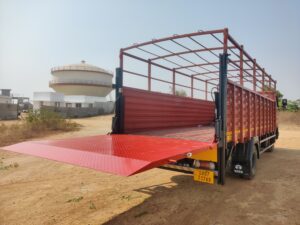Are you searching for a dependable and efficient solution to streamline the loading and unloading of heavy cargo? Hydraulic tail lifts are the answer. These versatile devices are essential in industries such as logistics, transportation, and manufacturing. This comprehensive guide covers everything you need to know about hydraulic tail lifts, from their operation and benefits to maintenance tips and safety measures.
Whether you’re a business owner looking to improve workflows or a truck driver aiming to optimize operations, this guide is tailored for you.
What Are Hydraulic Tail Lifts, and How Do They Work?
Hydraulic tail lifts are mechanical devices designed to assist in lifting and lowering heavy cargo on vehicles like trucks and vans. They rely on hydraulic power, which involves using pressurized fluid to create controlled movement.

When the operator activates the lift, hydraulic fluid is pumped into a cylinder, extending it and raising the lift platform. Key components include:
- Hydraulic Pump: Generates pressure for movement.
- Control Valves: Regulate the hydraulic fluid flow.
- Lift Platform: A sturdy surface that supports the cargo.
Advanced models may also include horizontal extension capabilities, enabling easier cargo access in tight spaces. With features like non-slip surfaces and side guards, hydraulic tail lifts ensure both operator safety and cargo security.
Types of Hydraulic Tail Lifts
Hydraulic tail lifts come in several configurations to meet diverse needs:
- Column Lifts: Feature vertical columns for stability and are ideal for vehicles with higher loading thresholds.
- Cantilever Lifts: Utilize an arm-like design for maneuverability in tight spaces, making them perfect for urban deliveries.
- Tuck-Away Lifts: Retract under the vehicle when not in use, preserving aerodynamics and providing unobstructed access to the vehicle’s cargo area.
Selecting the right type depends on factors such as vehicle type, cargo requirements, and operating conditions.
Benefits of Hydraulic Tail Lifts
Hydraulic tail lifts offer numerous advantages:
- Reduced Labor: Minimize physical effort and the risk of injuries.
- Versatility: Handle various cargo sizes and weights with ease.
- Improved Safety: Built-in safety features like emergency stop buttons and weight sensors enhance protection.
- Increased Efficiency: Streamline loading and unloading processes, reducing turnaround times.
By investing in hydraulic tail lifts, businesses can save on labor costs while boosting productivity and workplace safety.
Key Considerations for Selecting the Right Hydraulic Tail Lift
To select the right hydraulic tail lift, keep these factors in mind:
- Load Capacity: Verify that the lift can support your heaviest loads.
- Platform Dimensions: Match the platform size to your typical cargo.
- Lift Height: Verify the lift reaches the necessary heights for your operations.
- Vehicle Compatibility: Choose a lift compatible with your vehicle’s design.
- Operational Environment: Consider space constraints and maneuverability needs.
These considerations will help you find a solution tailored to your specific needs.
Maintenance and Safety Best Practices
Proper care extends the lifespan of hydraulic tail lifts and ensures safe operation:
- Routine Inspections: Regularly check hydraulic hoses, seals, and fluid levels for wear or leaks.
- Operator Training: Ensure personnel understand proper usage and safety protocols.
- Maintenance Schedule: Follow the manufacturer’s guidelines for servicing and keep records of maintenance.
Safety features, such as emergency stops and overload protection, should always be functional. Prioritize both maintenance and training to maximize efficiency and safety.
Common Issues and Troubleshooting
Even with proper care, hydraulic tail lifts may experience issues:
- Hydraulic Fluid Leaks: Check for worn hoses or seals and replace them promptly.
- Control Malfunctions: Inspect buttons, switches, and wiring if the lift is unresponsive.
- Smooth Operation: Address low fluid levels or air in the system to restore proper functionality.
Regular inspections and timely repairs can minimize disruptions and keep your lift in top shape.
Cost and ROI Analysis
Investing in hydraulic tail lifts can deliver substantial returns over time:
- Labor Savings: Reduce the need for manual handling, lowering labor costs.
- Increased Productivity: Faster loading and unloading improve operational efficiency.
- Enhanced Safety: Minimize workplace injuries, cutting insurance costs.
While the initial purchase may seem significant, the long-term benefits often outweigh the costs, providing an excellent return on investment.
Conclusion
Hydraulic tail lifts are transformative tools for improving cargo handling operations. They enhance efficiency, reduce manual labor, and prioritize safety, making them indispensable in logistics and transportation.
By understanding their functionality, types, and key considerations, businesses can make informed decisions and select the right hydraulic tail lift for their needs. Prioritize maintenance and safety to ensure long-lasting performance and reliability.
As industries evolve and demand for efficient operations grows, hydraulic tail lifts will continue to play a vital role in meeting these challenges. Invest in this technology to optimize your processes, enhance safety, and stay competitive in a fast-paced market.
